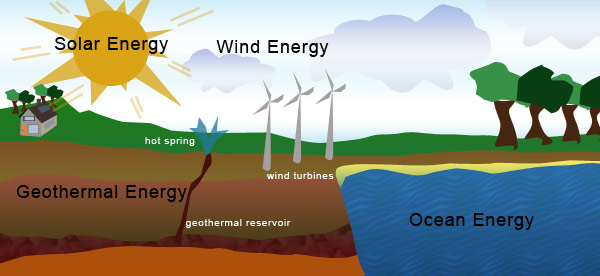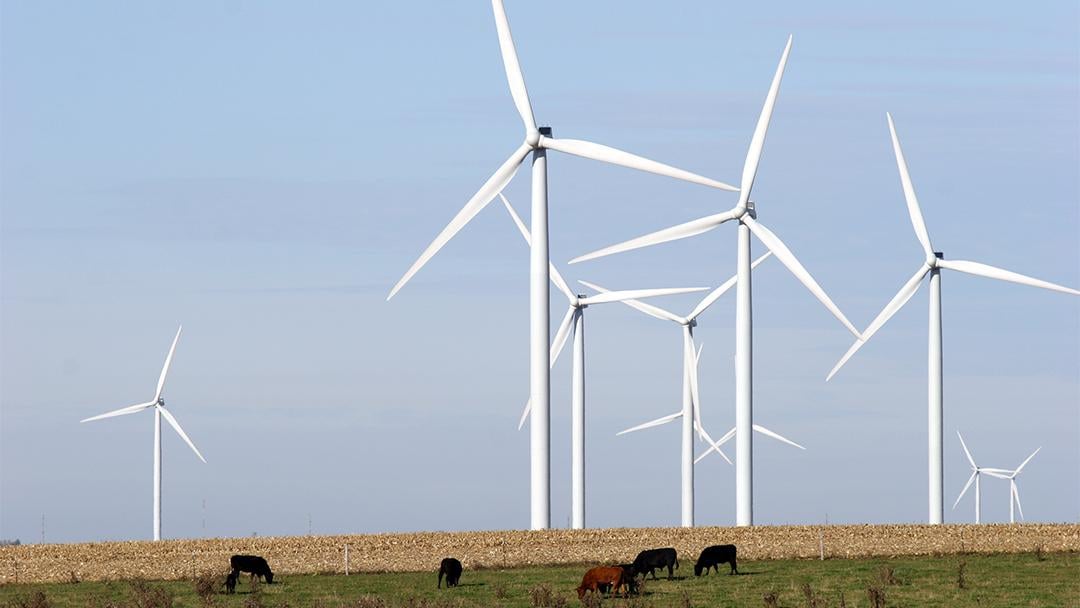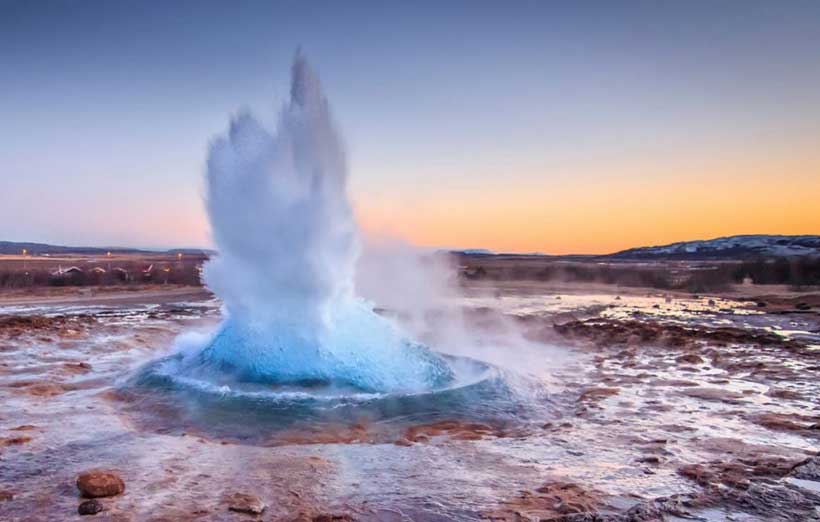Sources of Energy
Energy

Energy is the capacity of a physical system to perform work. Energy exists in several forms such as heat , kinetic or mechanical energy, light, potential energy , electrical, or other forms.Energy sources could be classified as Renewable and Non-renewable.
Renewable Energy
The resources which are being continuously consumed by man but are renewed by nature constantly are called as Renewable Resources. These resources are inexhaustible because they cannot be exhausted permanently like Solar Energy ,Wind energy ,Biomass and Bio fuels ,Water and Geothermal
Non-renewable Energy
The resources which are non-renewable are called as Non-Renewable sources. The Non-Renewable resources do not replenish and cannot be renewed. It took thousands of years of time to form the non-renewable resources which exist inside the earth in the form of coal, fossil fuels, etc.
Sources of Energy
Two Basic Types of Sources of Energy They Are
- Conventional:Fossil Fuels, Thermal Power Plant, Hydro Power Plants,Wind Energy
- Non-Conventional: Solar Energy, Geothermal Energy, Wave or Tidal Energy
CONVENTIONAL SOURCES OF ENERGY
Conventional sources of energy are the sources that are commonly in use since long time.
They can be exhausted due to over consumption.
Fossil Fuels

The growing demand for energy was largely met by the fossil fuels – coal and petroleum. Our technologies were also developed for using these energy sources. But these fuels were formed over millions of years ago and there are only limited reserves. The fossil fuels are non-renewable sources of energy, so we need to conserve them. If we were to continue consuming these sources at such alarming rates, we would soon run out of energy
Coal, Oil and Natural gas are the non-renewable sources of energy. They are also called fossil fuels as they are products of plants that lived thousands of years ago. Fossil fuels are the predominantly used energy sources today. India is the third largest producer of coal in the world, with estimated reserves of around 315,148.81 million tonnes of Geological Resources of Coal (as of 1.4.2017). Coal supplies more than 58% of the country’s total primary energy requirements. India consumes about 210 MT of crude oil annually, and more than 70% of it is imported. Burning fossil fuels cause great amount of environmental pollution.
Disadvantages
- Air pollution caused
- The oxides of carbon, nitrogen and sulphur that are released on burning fossil fuels are acidic oxides. These lead to acid rain which affects our water and soil resources.
- Green-house effect of gases like carbon dioxide.
Thermal Power Plant:

Large amount of fossil fuels are burnt every day in power stations to heat up water to produce steam which further runs the turbine to generate electricity. Transmission of electricity is more efficient than transporting coal or petroleum over the same distance. Therefore, many thermal power plants are set up near coal or oil fields.
Hydro Power Plants

It uses kinetic energy of flowing water or the potential energy of water at a heightand convert the potential energy of falling water into electricity.
In order to produce hydel electricity, high-rise dams are constructed on the river to obstruct the flow of water and thereby collect water in larger reservoirs. The water level rises and in this process the kinetic energy of flowing water gets transformed into potential energy. The water from the high level in the dam is carried through pipes, to
the turbine.
- It is a renewable source of energy.
Disadvantages
- Dams can be constructed only in a limited number of places, preferably in hilly terrains.
- Large areas of agricultural land and human habitation are to be sacrificed as they get submerged.
- Large eco-systems are destroyed when submerged under the water in dams.
- The vegetation which is submerged rots under anaerobic conditions and gives rise to large amounts of methane which is also a green-house gas. It creates the problem of satisfactory rehabilitation of displaced people.
Improvements in the Technology for using Conventional Sources of Energy
Biomass

Fuels like wood and cow-dung cakes are plant and animal products, thus the source of these fuels is said to be bio-mass.
They do not produce much heat on burning and a lot of smoke is given out when they are burnt.
The plants fix solar energy through the process of photosynthesis to produce biomass. This biomass passes through various cycles producing different forms of energy sources. For example, fodder for animals that in turn produce dung, agricultural waste for cooking, etc. The current availability of biomass in India is estimated at about 500 million MT per annum, with an estimated surplus biomass availability of about 120 – 150 million metric tones per annum covering agricultural and forestry residues. This corresponds to a potential of about 18,000 MW. An additional 7000 MW power could be generated through bagasse based cogeneration in the country’s Sugar mills.
Usage
Biomass is an important source of energy accounting for about one third of the total fuel used in our country and in about 90% of the rural households. The widespread use of biomass is for household cooking and heating. The types of biomass used are agricultural waste, wood, charcoal or dried dung.
Advantages
-Available locally and to some extent abundantly
-It is a relatively clean fuel when compared to fossil fuels. In a way biomass also cleans our environment by trapping carbon- di-oxide
Disadvantages
-Drudgery involved in collection of fuel
-During indoor cooking and in the absence of sufficient ventilation fuels such as dung cause air pollution which is a serious health hazard
-Unsustainable and inefficient use of biomass often leads to destruction of vegetation and hence environmental degradation.
-Technologies for productive use of biomass.
Technologies that enable efficient use of biomass are becoming prevalent in rural areas.The efficiency of fuel usage is increased by:
Wind Energy

Wind is the natural movement of air across the land or sea. This kinetic energy of the blowing wind can be used to do work. This energy was harnessed by windmills in the past to do mechanical work.
The wind when used to turn the blades of a wind mill turns the shaft to which they are attached. This movement of shaft through a pump or generator produces electricity.
It is a source of renewable energy.
The Potential for wind power generation for grid interaction has been estimated at about 1,02,788 MW taking sites having wind power density greater than 200 W/sq. m at 80 m hub-height with 2% land availability in potential areas for setting up wind farms @ 9 MW/sq. km. India now has the 5th largest wind power installed capacity in the world which has reached 32715.37 MW (as on Oct, 2017). The total wind power capacity added to the country in 2017-18 (as on Oct, 2017) has come up to 435.61 MW. Private agencies own 95 % of the wind farms in India.
Advantages
-It is environment friendly
-Its freely and abundantly available
Disadvantages
- High investment requirement
- Wind speed is not uniform all the time which affects power generated
- Output of a single windmill is quite small and cannot be used for commercial purposes.
- wind energy farms can be established only at those places where wind blows for the greater part of a year.
- The wind speed should also be higher than 15 km/h to maintain the required speed of the turbine.
- There should be some back-up facilities (like storage cells) to take care of the energy needs during a period when there is no wind.
ALTERNATIVE OR NON- CONVENTIONAL SOURCES OF ENERGY.
Non-conventional sources of energy refers to the sources that are identified few decades ago.
They cannot be exhausted.
Some Non-Conventional Sources of Energy Discussed below:
Solar Energy

Sun is the primary source of energy. Sunlight is a clean, renewable source of energy. It is a sustainable resource, meaning it doesn’t run out, but can be maintained because the sun shines almost every day. Coal or gas are not sustainable or renewable: once they are gone, there is none left. More and more people are wanting to use clean, renewable energy such as solar, wind, geothermal steam and others. It is called ‘Green Power’. It lights our houses by day, dries our clothes and agricultural produce, keeps us warm and lots more. Its potential is however much larger
Advantages
-It is a perennial, natural source and free
-It is available in plenty
-It is non-polluting
-It does not emit any green house gases.
-Solar energy offers decentralization in most (sunny) locations, meaning self-reliant societies.
-One of the biggest advantages of solar energy is the ability to avoid the politics and price volatility that is increasingly characterizing fossil fuel markets.
-It doesn’t result in the destruction of forests and eco-systems that occurs with most fossil fuel operations.
Disadvantages
-Dependent on change in seasons / weather – hence they may not be used always
-Requires high initial investments for productive use
-Solar systems doesn’t work at night directly but the battery bank, which stores energy during day-time can be used during night.
-Solar electricity storage technology has not reached its potential yet.
-Solar panels are bulky. This is particularly true of the higher-efficiency, traditional silicon crystalline wafer solar modules.
Technologies for productive use of solar energy
Solar energy can be used to generate electricity. Through Solar Photovoltaic (SPV) cells, solar radiation gets converted into DC electricity directly. The generated electricity can either be used as it is or can be stored in the battery. The stored electrical energy can be used when solar energy is not available. SPV is nowadays successfully used for home and street lighting and water pumping in villages. In hilly areas, solar water heating is also being used.
The cell develops a voltage of 0.5–1 V and can produce about 0.7 W of electricity when exposed to the Sun. A large number of solar cells are, combined in an arrangement called solar cell panel that can deliver enough electricity for practical use.
Water and geothermal Water/Tidal Energy and Wave Energy

Tidal Energy:Due to the gravitational pull of mainly the moon on the spinning earth,
the level of water in the sea rises and falls.
This phenomenon is called high and low tides and the difference in sea-levels gives us tidal energy.
The flowing water and the tides in the sea are sources of energy.
Tidal energy is harnessed by constructing a dam across a narrow opening to the sea. A turbine fixed at the opening of the dam converts tidal energy to electricity.
Heavy investments are made on large projects. In recent years, hydel energy (through mini and small hydel power plants) is also used to reach power to remote villages which are un-electrified. The estimated potential of Small Hydro Power is about 15,000 MW in the country. As on October 2017, the installed capacity of Small hydro projects (upto 3 MW) amounts to 4399.35 MW.
Wave Energy
The kinetic energy possessed by huge waves near the seashore can be trapped to generate electricity.A wide variety of devices have been developed to trap wave energy for rotation of turbine and production of electricity.
Ocean Thermal Energy
The water at the surface of the sea or ocean is heated by the Sun while the water in deeper sections is relatively cold. This difference in temperature is exploited to obtain energy in ocean-thermal-energy conversion plants.
These plants can operate if the temperature difference between the water at the surface and water at depths up to 2 km is 20 K (20°C) or more. The warm surface-water is used to boil a volatile liquid like ammonia. The vapours of the liquid are then used to run the turbine of generator.
Advantages of Small Hydro Power as an energy source
-Reliable, eco-friendly, mature and proven technology.
-More suited for the sensitive mountain ecology.
-Can be exploited wherever sufficient water flows -along small streams, medium to small rivers and also harness abundant sun-shine, wind-energy and other bio-energy sources.
-Does not involve setting up of large dams or problems of deforestation, submergence or rehabilitation.
-Non-polluting, entails no waste or production of toxic gases, environment friendly.
-Small capital investment and short gestation period.
-Minimal transmission losses.
-With careful planning and adoption of simplified and standardized designs, SHP installations are becoming increasingly competitive with thermal, diesel or gas based power generation.
Geothermal energy

Geothermal Energy is heat stored in earth crust and being used for electric generation and also for direct heat application. Geothermal literally means heat generated by earth. Various resource assessment carried out by agencies established the potential 10600 MWth /1000MWe spread over 340 hot springs across seven Geothermal provinces/11 states.
The availability of geothermal power is most environment-friendly power, round the year 24×7 basis, not affected by the severity of climate during 6 to 7 winter months like hydro and like dependence on sun in solar PV.
Nuclear Energy

In a process called nuclear fission, the nucleus of a heavy atom (such as uranium, plutonium or thorium), when bombarded with low-energy neutrons, can be split apart into lighter nuclei.
When this is done, a tremendous amount of energy is released if the mass of the original nucleus is just a little more than the sum of the masses of the individual products.
The fission of an atom of uranium, for example, produces 10 million times the energy produced by the combustion of an atom of carbon from coal.
In a nuclear reactor designed for electric power generation, such nuclear ‘fuel’ can be part of a self sustaining
fission chain reaction that releases energy at a controlled rate. The released energy can be used to produce steam and further generate electricity.
Disadvantages
- Storage and disposal of spent or used fuels becomes a problem as the uranium still decaying into harmful
subatomic particles (radiations). - Improper nuclear-waste storage and disposal result in environmental contamination
- Risk of accidental leakage of nuclear radiation.
- High cost of installation of a nuclear power plant, high risk of environmental contamination and limited availability of uranium makes large-scale use of nuclear energy prohibitive.
Biofuels
Bio fuels are predominantly produced from biomass feed stocks or as a by-product from the industrial processing of agricultural or food products, or from the recovery and reprocessing of products such as cooking and vegetable oil. Bio fuel contains no petroleum, but it can be blended at any level with petroleum fuel to create a bio fuel blend. It can be used in conventional heating equipment or diesel engine with no major modification. Bio fuel is simple to use, biodegradable, non-toxic and essentially free of Sulphur and aroma.
Since these fuels, however, do not produce much heat on burning and a lot of smoke is given out when they are burnt. Therefore, technological inputs to improve the efficiency of these fuels are necessary.
For example with the help of Technology we get Bio-gas out of Bio mass (gobar- gas )
- Bio-gas is an excellent fuel as it contains up to 75% methane. It burns without smoke, leaves no residue like ash in wood, charcoal and coal burning.
- Its heating capacity is high. Bio-gas is also used for lighting.
- The slurry left behind is removed periodically and used as excellent manure, rich in nitrogen and phosphorous.
- The large-scale utilisation of bio-waste and sewage material provides a safe and efficient method of
waste-disposal besides supplying energy and manure.
ENVIRONMENTAL CONSEQUENCES
Exploiting any source of energy disturbs the environment in some way or the other.
the source we would choose depends on factors such as the ease of extracting energy from that source, the
economics of extracting energy from the source, the efficiency of the technology available causes environmental damage .
Burning fossil fuels causes air pollution.
In some cases, the actual operation of a device like the solar cell may be pollution-free, but the assembly of the device would have caused some environmental damage.
